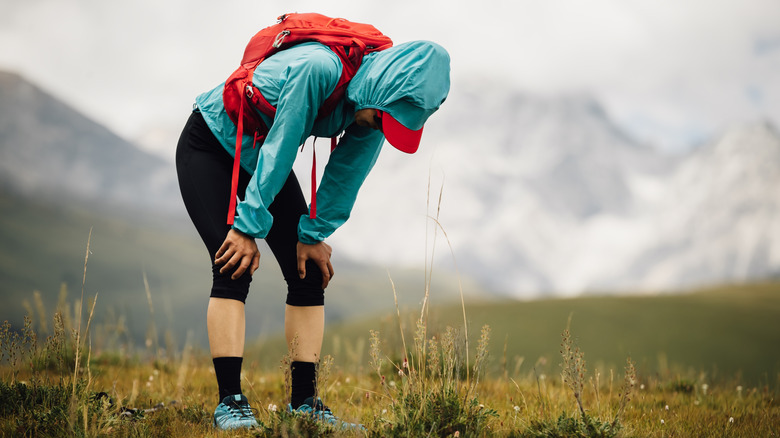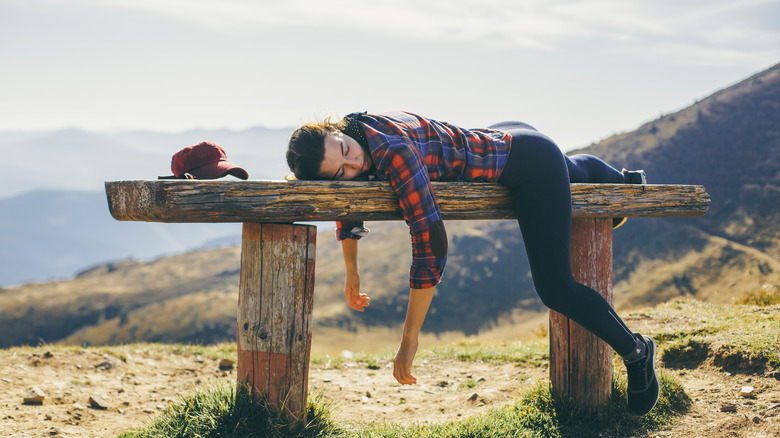What It Means To 'Bonk' While Hiking & How To Prevent It From Happening To You
Hiking long trails or tackling steep summits is exhilarating for many, and there are many must-visit destinations around the world for hikers, but it also carries a risk of "bonking," a colloquial term that describes a sudden and severe drop in energy that leaves hikers struggling to continue. The term originated in the cycling community in the mid-20th century, and gained traction among endurance athletes to describe the overwhelming fatigue that hits when the body simply runs out of fuel. It's not just a casual term. It reflects a physiological state known as exercise-induced hypoglycemia, when blood sugar and glycogen stores in your muscles plummet due to prolonged exertion. In layman's terms, bonking is like your body's fuel tank hitting empty, leaving you unable to power your muscles effectively. For hikers, this can manifest as dizziness, weakness, or even nausea.
Bonking is particularly dangerous because it doesn't just sap your energy, it can also compromise your health and safety. The depletion of glycogen, the body's main energy source during exercise, forces the body to burn fat or even muscle protein, which is much less efficient than burning glycogen and can also lead to muscle breakdown. It could even be seen as your body eating itself for energy.
This shift can also weaken your immune system, since it too relies on glycogen for fuel, thus increasing susceptibility to illness and potentially disrupting training plans. On the trail, bonking can impair coordination and focus, raising the risk of falls or poor decision-making in remote areas. For hikers, who often travel far from immediate help, this can pose dangerous risks, making prevention critical.
The causes of bonking while hiking
The primary cause of bonking is a nutritional imbalance that leaves the body without enough readily available energy when it needs it. When you hike, especially over long distances or challenging terrain, your muscles rely on glycogen, a stored form of carbohydrates, to fuel movement. Most hikers carry enough glycogen stores for about two hours of moderate intensity activity without the need for additional calorie intake. Once these stores drop significantly, the muscles struggle to function, leading to the hallmark symptoms of bonking: lightheadedness, muscle cramps, shaky hands, and profound exhaustion.
This energy crisis often stems from inadequate planning or underestimating caloric needs. Hikers may skip meals, forget to snack, or misjudge the intensity of their own route, and so they burn through their energy stores fast without refueling along the way. Dehydration can make problems worse, as it impairs the body's ability to process carbohydrates efficiently.
Another theory as to bonking's cause revolves around the brain's role as the "central governor," of the body, as the brain might limit muscle functioning to prevent damage when energy levels dip too low. This protective mechanism can shut down performance prematurely and leave hikers feeling mentally foggy, extremely weak, and zoned out. Missing a snack, forgetting to eat consistently, and a general energy shortage on long outings, is a common mistake setting the stage for bonking.
How to prevent bonking while on the trail
In order to prevent bonking, hikers should be proactive about nutrition and prepare a tailored plan. Do research on what works for your body and what doesn't. Eat a meal the night before rich in carbohydrates like pasta or rice, to maximize glycogen stores. On the day of the hike, eat a balanced breakfast a few hours before starting, combining protein and carbs for sustained energy. During the hike, keep a bonk first aid kit with gels, gummies and electrolyte drinks, which are quickly absorbed and easy to carry. Test these foods during training hikes to make sure they sit well with your personal constitution. As with everything, each individual body is unique, and the best thing for preventing bonking is to ensure the body has enough glycogen stores prior to an endurance event.
Planning is key, and what it takes to summit the highest mountain in the lower 48. So set a schedule to eat and drink at regular intervals, even if you don't feel hungry or thirsty, as waiting for these cues has the potential to be too late. Hydration is equally important, so carry enough water or electrolyte drinks to keep hydration levels up.
Training for your hike is another key ingredient. Regular endurance practice helps the body use glycogen more efficiently and allows you to experiment with nutrition strategies. If you feel early signs of bonking, like hunger or irritability, act quickly by consuming a gel and resting briefly to let it absorb, but avoid resting too long that can make restarting feel harder. Stay hydrated, stay fueled, have a plan, and listen to your body to avoid the nefarious bonk on your next bucket list adventure hike.


